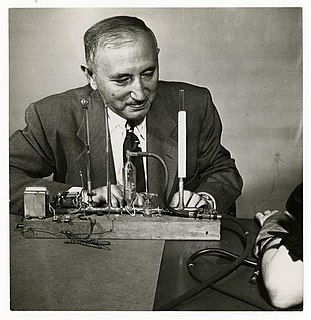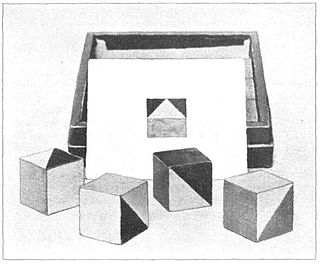The Flynn effect is the substantial and long-sustained increase in both fluid and crystallized intelligence test scores that were measured in many parts of the world over the 20th century. When intelligence quotient (IQ) tests are initially standardized using a sample of test-takers, by convention the average of the test results is set to 100 and their standard deviation is set to 15 or 16 IQ points. When IQ tests are revised, they are again standardized using a new sample of test-takers, usually born more recently than the first. Again, the average result is set to 100. However, when the new test subjects take the older tests, in almost every case their average scores are significantly above 100.

An intelligence quotient (IQ) is a total score derived from a set of standardized tests or subtests designed to assess human intelligence. The abbreviation "IQ" was coined by the psychologist William Stern for the German term Intelligenzquotient, his term for a scoring method for intelligence tests at University of Breslau he advocated in a 1912 book.
Discussions of race and intelligence – specifically, claims of differences in intelligence along racial lines – have appeared in both popular science and academic research since the modern concept of race was first introduced. With the inception of IQ testing in the early 20th century, differences in average test performance between racial groups were observed, though these differences have fluctuated and in many cases steadily decreased over time. Further complicating the issue, modern science has shown race to be a social construct rather than a biological reality, and intelligence has no undisputed definition. The validity of IQ testing as a metric for human intelligence is itself disputed. Today, the scientific consensus is that genetics does not explain differences in IQ test performance between racial groups, and that observed differences are therefore environmental in origin.

Human intelligence is the intellectual capability of humans, which is marked by complex cognitive feats and high levels of motivation and self-awareness. High intelligence is associated with better outcomes in life.
The g factor is a construct developed in psychometric investigations of cognitive abilities and human intelligence. It is a variable that summarizes positive correlations among different cognitive tasks, reflecting the fact that an individual's performance on one type of cognitive task tends to be comparable to that person's performance on other kinds of cognitive tasks. The g factor typically accounts for 40 to 50 percent of the between-individual performance differences on a given cognitive test, and composite scores based on many tests are frequently regarded as estimates of individuals' standing on the g factor. The terms IQ, general intelligence, general cognitive ability, general mental ability, and simply intelligence are often used interchangeably to refer to this common core shared by cognitive tests. The g factor targets a particular measure of general intelligence.
Intellectual giftedness is an intellectual ability significantly higher than average. It is a characteristic of children, variously defined, that motivates differences in school programming. It is thought to persist as a trait into adult life, with various consequences studied in longitudinal studies of giftedness over the last century. There is no generally agreed definition of giftedness for either children or adults, but most school placement decisions and most longitudinal studies over the course of individual lives have followed people with IQs in the top 2.5 percent of the population—that is, IQs above 130. Definitions of giftedness also vary across cultures.

David Wechsler was a Romanian-American psychologist. He developed well-known intelligence scales, such as the Wechsler Adult Intelligence Scale (WAIS) and the Wechsler Intelligence Scale for Children (WISC). A Review of General Psychology survey, published in 2002, ranked Wechsler as the 51st most cited psychologist of the 20th century.
The Wechsler Adult Intelligence Scale (WAIS) is an IQ test designed to measure intelligence and cognitive ability in adults and older adolescents. The original WAIS was published in February 1955 by David Wechsler, as a revision of the Wechsler–Bellevue Intelligence Scale, released in 1939. It is currently in its fourth edition (WAIS-IV) released in 2008 by Pearson, and is the most widely used IQ test, for both adults and older adolescents, in the world.

A block design test is a subtest on many IQ test batteries used as part of assessment of human intelligence. It is thought to tap spatial visualization ability and motor skill. The test-taker uses hand movements to rearrange blocks that have various color patterns on different sides to match a pattern. The items in a block design test can be scored both by accuracy in matching the pattern and by speed in completing each item. Einstein had very advanced spatial abilities.

Lewis Madison Terman was an American psychologist and author. He was noted as a pioneer in educational psychology in the early 20th century at the Stanford Graduate School of Education. He is best known for his revision of the Stanford–Binet Intelligence Scales and for initiating the longitudinal study of children with high IQs called the Genetic Studies of Genius. He was a prominent eugenicist and was a member of the Human Betterment Foundation. He also served as president of the American Psychological Association. A Review of General Psychology survey, published in 2002, ranked Terman as the 72nd most cited psychologist of the 20th century, in a tie with G. Stanley Hall.
Cognitive tests are assessments of the cognitive capabilities of humans and other animals. Tests administered to humans include various forms of IQ tests; those administered to animals include the mirror test and the T maze test. Such study is important to research concerning the philosophy of mind and psychology, as well as determination of human and animal intelligence.
The Wechsler Intelligence Scale for Children (WISC) is an individually administered intelligence test for children between the ages of 6 and 16. The Fifth Edition is the most recent version.
Catharine Morris Cox Miles was an American psychologist known for her work on intelligence and genius. Born in San Jose, CA, to Lydia Shipley Bean and Charles Elwood Cox. In 1927 married psychologist Walter Richard Miles. Her sister was classics scholar and Quaker administrator Anna Cox Brinton.
Research on the heritability of IQ inquires into the proportion of variance in IQ that is attributable to genetic variation within a population. Heritability, in this sense, is a mathematical estimate of how much of a trait's variation within a population can be attributed to genetic variation between individuals in that population. There has been significant controversy in the academic community about the heritability of IQ since research on the issue began in the late nineteenth century. Intelligence in the normal range is a polygenic trait, meaning that it is influenced by more than one gene, and in the case of intelligence at least 500 genes. Further, explaining the similarity in IQ of closely related persons requires careful study because environmental factors may be correlated with genetic factors.
Picture arrangement test is a test that consists of a series of comic-strip-like pictures that are presented in a random order. The subject is given the task to arrange the pictures as quickly as possible so that a reasonable and meaningful story is formed. This is an example of a common feature found in intelligence tests. As the demand for psychological testing has increased, this type has seen increased use throughout Psychology. There are several different ways and scales that can be used with this test to measure different kind of intelligence. Different tests over time have been created to measure different things. One scale that has been developed and used with these tests has been the Wechsler Adult Intelligence Scale which breaks down ones full performance IQ into subsets like verbal IQ and performance IQ, getting more specific and elaborate as the scale for each individual develops. The reliability of this test has been disputed, however. For example, patients suffering from schizophrenia have been found to score as more "normal" than patients with no such mental disorders.

IQ classification is the practice by IQ test publishers of labeling IQ score ranges with category names such as "superior" or "average".
The Planning, Attention-Arousal, Simultaneous and Successive (PASS) theory of intelligence, first proposed in 1975 Das, Kirby, and Jarman (1975), and later elaborated by Das, Naglieri & Kirby (1994) and Das, Kar & Parrila, (1996) challenges g-theory on the grounds that the brain is made up of interdependent, but separate, functional systems. Neuroimaging studies and clinical studies of individuals with brain lesions make it clear that the brain is modularized; for example, damage to a very specific area of the left temporal lobe will impair the production of spoken and written language. Damage to an adjacent area will have the opposite impact, preserving the individual's ability to produce, but not understand speech and text.
The following outline is provided as an overview of and topical guide to human intelligence:
The Wechsler Test of Adult Reading (WTAR) is a neuropsychological assessment tool used to provide a measure of premorbid intelligence, the degree of Intellectual function prior to the onset of illness or disease.
Differences in human intelligence have long been a topic of debate among researchers and scholars. With the advent of the concept of g factor or general intelligence, many researchers have argued that there are no significant sex differences in general intelligence, although ability in particular types of intelligence does appear to vary.






